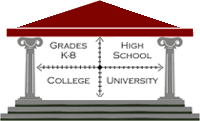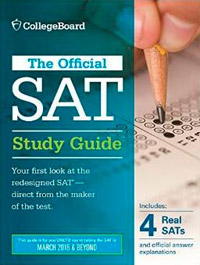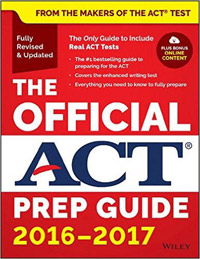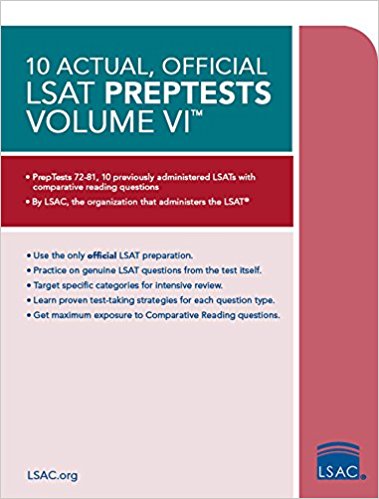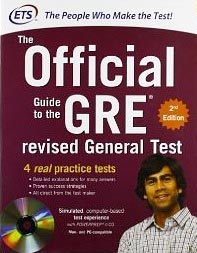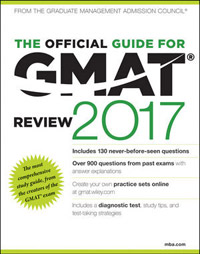|
BRIAN McELROY'S CRITICAL READING TIPS FOR THE SAT
*Important passages are highlighted in BOLD*
-UNLESS YOU'RE A FAST READER, YOU WILL MOST LIKELY EITHER SKIM THROUGH OR SKIP THE PASSAGE ENTIRELY THE FIRST TIME THROUGH. By now, almost everyone has heard some version of this piece of advice, but despite seeming too good to be true, it is truly an effective technique for most. It works because reading the passage beforehand is usually little more than a huge waste of time. Students who do this usually read the passage line-by-line, focusing on every detail, only to realize by the time they’ve reached the end of the passage they don’t remember much of anything. So when they finally move on to the actual questions, they have to go back to the passage and re-read the text anyway. Why not just go directly to the questions (or at least skim the passage quickly) and give yourself twice as much time to answer the questions? You’ll also avoid getting “stuck” on a section of the passage that is unimportant—remember, there is a lot of information presented in the passages, but the questions only ask about some of this information, not all of it.
-Another good reason to skim or skip over the passage is that the questions appear in rough chronological order. That is, the first question refers to the beginning of the passage, the last question refers to the end of the passage, etc. So by answering the questions one at a time, and reading the corresponding passages, you are actually reading the entire passage anyway.
-Remember, Critical Reading has no order of difficulty, so you don’t have to answer the questions in any particular order. Feel free to skip harder questions or questions that you don’t understand. After all, if you don’t understand the question or don’t know the meaning of a key word in the question, you’re probably not going to get it right anyway! The worst thing that can happen is that you skip too many and end up at the end of the section before time has expired. If this happens to you, it’s no big deal—just backtrack and answer some of the questions you skipped.
-Questions with line references are generally the best questions to start with, because they tell you exactly where to look for the answer. However, remember that the key to the answer is not always in the EXACT lines that the question points you to. You often have to read a few lines above or below to find the answer. You should be able to determine whether to look above or below after reading the text.
-On the other hand, main idea or general questions should be saved for the end because they require knowledge of the entire passage. Other good questions to skip or at least save for later (because they are usually difficult and time-consuming) are the ROMAN NUMERAL questions (I,II,II etc.) and the “capital letter” (LEAST/EXCEPT/NOT) questions.
-Smart students: DON’T THINK SO HARD! Every year I see very intelligent students and excellent writers getting lousy scores on the SAT Critical Reading practice tests because they get too creative with the answers, and try to make too many connections, imagining hypothetical situations that could SOMEHOW make the answer true. I hate to admit that this works so well, but for this test, DON’T THINK POSITIVELY AND CREATIVELY. Instead you should BE NEGATIVE (meaning try to DISPROVE answers, not CHOOSE answers), and look at things with a crucial eye, not an optimistic one. Think of it this way: 80% of the answers you consider are going to be WRONG, so it’s better to distrust an answer than to trust it. This isn’t called CRITICAL Reading for nothing.
-With the short passages, you can get away with reading the entire passage because it’s so short that you usually will be able to retain everything. However, it makes sense to read the questions first, just to give yourself an idea of what you should be paying attention to. For example, if the first question asks you about lines 8-12, you can place a bracket in the margins next to those lines. This tells you to read that section carefully. If the question mentions any specific text, go ahead and underline that text as well. The truth is, most of the stuff you read you WON’T be tested on, so don’t get stuck on minor details.
-The main reasons that students give when asked why they performed poorly on the Critical Reading section of the SAT are that they become “lost” in the passage, or frustrated, or confused, or just plain bored. This may seem like a lot of reasons, but in my opinion, they are all the result of one root cause: when students try to “bite off more than they can chew” by jumping straight to the answers after quickly reading the text. Critical Reading questions should not be seen as one long question—each question should be perceived as a number of small questions to answer. By breaking the process of answering the question into smaller bites, we make it much less stressful for the student, and you’re much more likely to answer the question correctly. Because if you lose your train of thought (which happens frequently to students in this section), you will not have to start over from scratch. You will simply have to repeat the last step.
The secret is in realizing that within any Critical Reading question lie 6 ESSENTIAL STEPS the test-taker must take before choosing an answer. Here are my recommended steps for any critical reading question:
BRIAN’S PATENTED 6-STEP CRITICAL READING TECHNIQUE
1) READ THE QUESTION (I know, duh). If it’s a long or complicated question, don’t worry yet about what it’s asking—just note the line reference and any specific language quoted from the text. ALL YOU NEED TO KNOW AT THIS POINT IS WHERE TO READ.
2) READ FOR UNDERSTANDING. Go to the specific lines that the question mentions and read that portion of the text. Some companies will suggest that you read “5 lines above to 5 lines below,” but I find this technique to be unnecessarily confusing. Start with the EXACT LINES that the question refers to, then decide whether to read up or down for more information. You will usually be able to decide this from the context of the passage. For example, if the passage mentions a pronoun such as “it,” that suggests you should read above to figure out what “it” is referring to.
During this step, you don’t need worry about answering the question just yet. Just worry about trying to understand what the passage is saying. Another useful tip when reading for understanding is to try reading the topic sentence of whatever paragraph to which the question is pointing. Good writers know that topic sentences should effectively summarize the message of the paragraph, so if you’re looking for the main idea of a line or lines, look at the topic sentence of that paragraph.
3) RE-READ THE QUESTION. This time, focus on what the question is truly asking. One of the things you’ll notice about Critical Reading questions is that they are rarely actual questions! Don’t take my word for it—look in the Official Guide to the SAT and see how many question marks you can find. Not many at all, right? This is because the vast majority of Critical Reading “questions” are not questions at all, but incomplete statements. And the answer choices are not answers—they are possible endings to the statement! So what does this mean for you? It means that you should usually FOCUS ON THE END OF EACH QUESTION, because this is where the question CONNECTS TO EACH ANSWER CHOICE.
Once you’ve got in mind what the question is truly asking for, another trick you can use is what I call “bringing the question to the passage.” This means writing a short summary of the question in the margin next to the passage, so your eyes (and your fingers when it’s on the other page) don’t have to jump back and forth between the two. For example, if the question says “the author mentions the quote from Thoreau in order to…” you could write “why mention Thoreau?” in the margins next to the text. It only takes a second to write down and it saves you a lot of hassle and/or page turning.
4) RE-READ THE PASSAGE, LOOKING FOR THE ANSWER IN YOUR OWN WORDS, OR (EVEN BETTER!), THE ANSWER IN THE TEXT. UNDERLINE KEY TERMS (ADJECTIVES, ADVERBS, VERBS). This is a very important part of the process, and a very powerful technique. Most students skip this step completely, preferring to peek ahead at the answers. It is VERY IMPORTANT THAT YOU DO NOT LOOK AT THE ANSWERS YET. Just as with the sentence completions, you will just confuse yourself if you start looking at the answer choices before you even have an idea of what the answer is. Avoid this temptation at all costs.
Instead, see if you can answer the question in your own mind. If so, write it down so you don’t forget! Or, you may be able to find certain lines in the passage that provide the answer to the question. Underline these lines. Now, in the same way that you did with the SENTENCE COMPLETIONS, you have given yourself a SPECIFIC answer to look for (or at least as specific as possible.)
Now, finally, on to step 5…
5) PROCESS OF ELIMINATION. Now that you have an answer written down, or underlined on your page, you can go ahead and start looking at the answers. Some will obviously be wrong, and others will be more vague.
Again, it helps to think of the correct answer as the “HARDEST TO DISPROVE” instead of the “best” answer. When you look for the right answer, you start looking for reasons to make something true, and when that happens, that’s where the SAT does a great job of TRICKING most students. You see, when you are trying to MAKE an answer choice work, you start getting CREATIVE (for life this is a good quality but for the SAT, not so much!), and try to think of ways that the question COULD possibly be right. This is not wise, however.
Instead, you should be looking at the SPECIFICS of the question (strong adjectives, adverbs, verbs etc) and trying to determine why it COULD NOT be right. This explains why on many questions (especially MAIN IDEA questions), the more general question is the answer. For example, what’s easier to disprove: that it SOMETIMES rains on cloudy days, or that rain is a DIRECT RESULT of thunder? Obviously the second one, right? Well that’s because of the qualifying words “sometimes” and “relatively,” as opposed to the stronger (and thus more committal) word, “direct.”
Think about it: how could you ever DISPROVE that something “SOMETIMES” happens? It’s nearly impossible because you would have to show that something NEVER HAPPENED EVEN ONCE, which is almost impossible. But to DISPROVE that something ALWAYS happens, well, all I need to do is find one example to the contrary and I’ve proved the theory wrong. And that’s why the SAT is more about LOGIC than any other factor.
Allow me to provide an example. In the OFFICIAL SAT STUDY GUIDE, open your book to page 393, #19 and take a look at the question and answers. Give it a shot yourself.
What happens to many students in this scenario is that they eliminate it down to A and C. Many will choose C because it looks good and is in fact quite close to the answer (except it’s the other way around—should be “…Europeans about Native Americans.”). But think about it: answer choice A means exactly the same thing as answer choice C, except answer choice A is much more vague and therefore very HARD TO DISPROVE. Therefore A is the answer.
6) PROCESS OF SELECTION /ANSWER VERIFICATION. After process of elimination, you’ll probably narrow it down to at least three answers, probably two, or maybe you’ve even found the answer that you suspect is the correct one. NOW you can finally focus on VERIFYING the correct answer. So how do you do this? It’s all about LANGUAGE.
THE BEST ANSWER IS THE ANSWER WITH THE LANGUAGE CLOSEST TO THAT OF THE PASSAGE. LOOK FOR PARALLEL STRUCTURE AND MEANING BETWEEN THE ANSWER CHOICES AND THE TEXT YOU’VE UNDERLINED OR THE ANSWER YOU’VE WRITTEN DOWN IN THE BLANK SPACE AFTER THE QUESTION. DON’T BACKTRACK UNLESS YOU HAVE TO. TRUST THE TECHNIQUE, IT WORKS.
SOME FINAL ADVICE FOR STUDENTS WHO OFTEN GET IT DOWN TO TWO ANSWERS BUT STILL ARE CHOOSING THE WRONG ONE:
Try not to choose answers that LOOK OR SOUND GOOD but are irrelevant to the question. Just because something is TRUE doesn’t mean it’s the right answer. Take another peek at the END OF THE QUESTION and the BEGINNING OF THE ANSWER, and remember that these are THE MOST ESSENTIAL PARTS TO ANY CRITICAL READING QUESTION.
Regards,
Brian
Back to Blog Home
|

